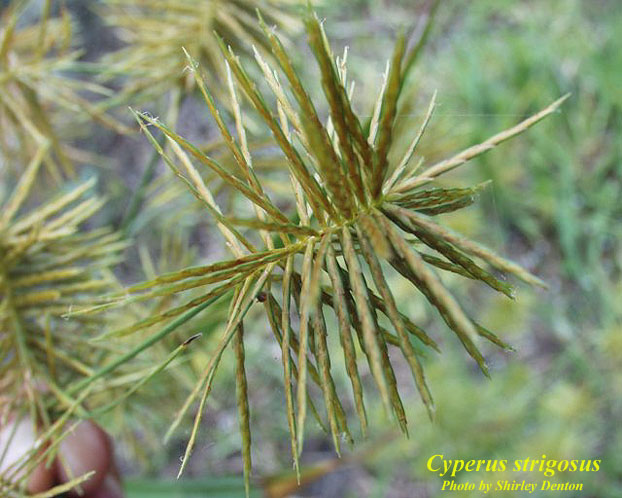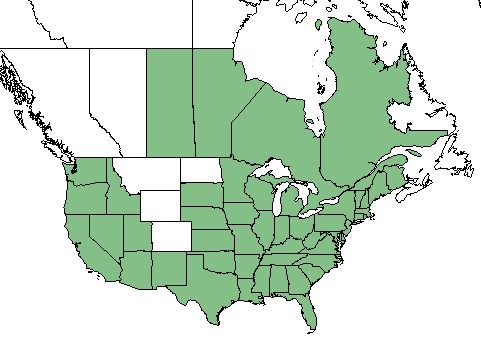Cyperus strigosus
Common name: Strawcolored Flatsedge [1], False Nutsedge [2]
| Cyperus strigosus | |
|---|---|

| |
| Photo by the Atlas of Florida Plants Database | |
| Scientific classification | |
| Kingdom: | Plantae |
| Division: | Magnoliophyta - Flowering plants |
| Class: | Liliopsida - Moncots |
| Order: | Cyperales |
| Family: | Cyperaceae |
| Genus: | Cyperus |
| Species: | C. strigosus |
| Binomial name | |
| Cyperus strigosus L. | |

| |
| Natural range of Cyperus strigosus from USDA NRCS Plants Database. | |
Contents
Taxonomic Notes
Synonyms: C. strigosus L. var. strigosus; C. strigosus L. var. robustior Britton; C. strigosus L. var. stenolepis (Torrey) Kükenthal; C. praelongatus Steudel; C. stenolepis Torrey
Varieties: none
Description
C. strigosus is a perennial graminoid of the Cyperaceae family native to North America and Canada. [1]
Distribution
C. strigosus can be found in all of the United States excluding North Dakota, Montana, Wyoming, and Colorado, as well as in the Quebec, Ontario, Manitoba, and Saskatchewan regions of Canada. [1]
Ecology
Habitat
C. strigosus can be found in marshes, ditches, wet flatwoods, and wet disturbed areas. [2] It has been observed in a range of habitats, including hammocks, salt marshes, wet disturbed areas, bottom flats and peaty flats, wet pond margins and other shorelines, slopes, and other wet areas. Soils include wet loamy sand, wet sandy loam, drying loamy sand, and wet sandy peat.[3] It is listed as a facultative wetland species, where it is most commonly found in wetland areas, but can occasionally be found in non-wetland habitats.[1]
Associated species: Aeschynomene sp., Polygonum sp., Rhynchospora sp., Cyperus polystachyos, C. pseudovegetus, C. surinamensis, Pontederia sp., Sagittaria engelmannii, Commelina sp., Hypoxis sp., Sacciolepis striata, Ludwigia sp., Phyla sp., Ipomoea sp., Bidens mitis, Solidago fistulosa, Heteranthera sp., Coelorachis rugosa, Hyptis alata, Boltonia caroliniana, Eupatorium serotinum, Polypremum procumbens, and other grasses.[3]
Phenology
C. strigosus has been observed to flower between June and July.[4] It is also known to flower from July to October as well.[2]
Fire ecology
C. strigosus is fire resistant, and has a medium fire tolerance. [1]
Use by animals
C. strigosus is palatable for grazing animals, but not for humans. [1]
Conservation and Management
C. strigosus is classified as a weedy or invasive species by the Southern Weed Science Society, Champaign, Illinois. [1]
Cultivation and restoration
Photo Gallery
References and notes
- ↑ 1.0 1.1 1.2 1.3 1.4 1.5 1.6 USDA Plant Database https://plants.usda.gov/core/profile?symbol=CYST
- ↑ 2.0 2.1 2.2 Weakley, A. S. (2015). Flora of the Southern and Mid-Atlantic States. Chapel Hill, NC, University of North Carolina Herbarium.
- ↑ 3.0 3.1 URL: http://herbarium.bio.fsu.edu. Last accessed: June 2018. Collectors: Loran C. Anderson, Sidney McDaniel, R. Kral, R.K. Godfrey, Norlan C. Henderson, Robert L. Lazor, Cecil R. Slaughter, T. MacClendon, K. MacClendon, Richard Carter, M. Darst, K. Burks, L. Peed, John B. Nelson, Rupert Kuhne, States and counties: Wakulla County Florida, Franklin County Florida, Okaloosa County Florida, Gadsden County Florida, Dixie County Florida, Jackson County Florida, Bay County Florida, Leon County Florida, Jefferson County Florida, Polk County Florida, Orange County Florida, Nassau County Florida, Madison County Florida, Thomas County Georgia, Osceola County Florida, Calhoun County Florida, Washington County Florida, Liberty County Florida, Waller County Texas, Walton County Florida, Okeechobee County Florida, Gulf County Florida, Calhoun County South Carolina,
- ↑ Nelson, G. PanFlora: Plant data for the eastern United States with emphasis on the Southeastern Coastal Plains, Florida, and the Florida Panhandle. www.gilnelson.com/PanFlora/ Accessed: 21 MAY 2018